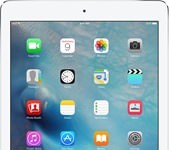 BusinessWeek has given us less than complete coverage of the Sony Reader, failing to pick up the format nuances. Now U.S. News & World Report is out with Publish or Panic, a more general article on the book biz–parts of which discuss the Sony, the iLiad from iRex Technologies and the forthcoming Readius from Philips Polymer Vision. Yes, the Sony is old news, so let’s cut to the chase with details on the Readius and iLiad:
BusinessWeek has given us less than complete coverage of the Sony Reader, failing to pick up the format nuances. Now U.S. News & World Report is out with Publish or Panic, a more general article on the book biz–parts of which discuss the Sony, the iLiad from iRex Technologies and the forthcoming Readius from Philips Polymer Vision. Yes, the Sony is old news, so let’s cut to the chase with details on the Readius and iLiad:
Two other devices are being readied for U.S. markets for 2007: The Readius, from the Netherlands-based Philips Polymer Vision, features a 5-inch diagonal screen that unfurls from a much smaller, cellphone-size container. “It’s the first time the screen will be larger than the device,” says Edward van Overbeek, the company’s director of business development. By contrast, the iLiad from iRex Technologies, also in the Netherlands, is about the size of a magazine and is accompanied by a stylus that allows you to “write” in the margins or zoom in to, say, one headline among many on a newspaper page…
Hmm. Is that “2007” a mistake about the Readius and the iLiad? Last I knew, the iLiad was coming out in the spring of 2006. But wait. Does the qualifier “U.S. markets” make the iLiad mention correct about 2007? I’m skeptical, but I could be wrong. As for the Readius, if a story in PC Magazine is indeed accurate, “Third-party designs of the Readius” will “ship” this summer. Er, ship? I assume we’re talking actual machines rather than than a pile of design papers or a bunch of bytes. Once again, I wonder about “U.S. markets.” Are both machines really not hitting our shores until next year, not even through mail order? I’ll e-mail Diane Cole, author of the cover story for the March 13 issue, and see what’s up. I’ll also write Philips Polymer Vision and iRex. U.S. News may well be right, and PC Magazine wrong or at least unclear about the Readius–especially in view of this info from Chris.
Overall, despite above questions, the U.S. News piece appears to be a very informative story, complete with some good news about paper books:
…book sales in 2005 increased. Nielsen BookScan recorded 709.8 million sales–a healthy 9.3 percent uptick from 2004.
Granted, U.S. News says just 200 best-sellers made up ten percent of those sales figures, but I’m still happy to see p-books faring a little better than when I last checked.
At the same time a study from the National Endowments for the Arts, also mentioned, documents a declining interest in serious literature. Ideally e-books and eventually copyright reform will help revive interest, at least if the e-book industry can do away with such problems as Draconian DRM and the Tower of eBabel.
Print-on-demand angle
Beyond p-books and pure e-books, U.S. News also discusses print on demand:
Print on demand–which makes it financially feasible to print small batches of books inexpensively–is already a boon for the self-published author…as well as for traditionally published authors seeking to reprint their out-of-print books. Now Jason Epstein, the former editorial director of Random House, is preparing to test a more sophisticated, even less expensive all-in-one book-making machine capable of producing up to 20 quality paperbacks an hour. The World Bank Bookstore in Washington, D.C., is installing the Espresso Book Machine, as Epstein calls it, later this month. Using digital files, the machine will be able to immediately print any book in the World Bank catalog. The chief benefit of the machine, says Epstein, is that a requested book would never be out of stock or out of print. Such a machine could make books less expensive, Epstein believes, because it would eliminate the need to warehouse and ship books; instead of guessing how many books to print–a game that leaves bookstores stuck with piles of unsold flops and readers unable to find out-of-stock surprise hits–the supply will always be just right. Will the Espresso brew satisfy? Technology–and copyright–updates on all these developments are sure to follow.
For those wanting to self-publish books printed on demand, U.S. News cluefully points to Lulu, where an old childhood friend of mine has had a happy experience. Lulu, as noted in the magazine, doesn’t cost you a penny if you use the basic service and let it share a cut of the revenue. Stephen “Tenebris” Fraser, a Lulu marketer who justifiably has complained about the major media’s undercoverage of Lulu, should be very pleased.
Friendly suggestion for a follow-up article
About the U.S. News story, I am, as noted, happy about its coverage of the book industry as a whole. But beyond the possible inaccuracies in parts on e-books, I’m disappointed that reporter Diane Cole wasn’t more sensitive to the serious issues raised by the Tower of eBabel. It would be terrific if she could follow up with a story examining the cultural, civic, business and consumer issues that the Tower raises. How can e-books become a serious medium if you can’t enjoy them in the future because the core formats are obsolete or the proprietary DRM thwarts you? Oh so correctly, the subhead of the U.S. News story reads, “The credibility of books is in a million little pieces.” Isn’t format durability part of long-term credibility?
Oh, yes, you could standardize on a format like Adobe’s PDF, but then you risk gouges from a Kongish vendor–not to mention the fact that Adobe and some other companies are more interested in short-term commercial successes than in the future progress of the e-book industry as a whole.
U.S. News links: (1) The credibility of books is in a million little pieces. The Web is stealing readers. But publishers are fighting back. (2) Bloggers embrace the printed page. (3) Print on demand can make you an author. (4) The Da Vinci Code.


































plain-text — the format whose longevity is already proven…
I don’t know about a U.S. release date, but I received a kind and prompt reply (same day) from an iRex representative to my question of an actual availability time and the representative indicated they are expecting to be able to have a consumer version of the iLiad available through their website in April 2006. The email instructed me to check the website again near the beginning of April to find out about availability, pricing and placing an order.
Giving Ms. Cole the benefit of the doubt, it could just be a typo. Especially when she says in the same article that the Readius, one of the two devices slated for “2007”, could begin shipping this summer.
Hi, Jared. I’ve written my own contact at iRex, and you may want to follow up with yours about the U.S. angle. I think that 2007 was a mistake, but let’s see. In the case of the Readius, things are a little unclear. In this case, too, I’ve followed up with the company.
I’ve also written Diane Cole to let her know about the questions, and it’ll be interesting to see what she has to say.
Thanks,
David
About release dates for U.S. markets, here’s the word from Diane Cole, who acted as I would have in her place:
“2007 was the date I was given for Readius. For the iLiad, spring 2006 was the date given for trials in Europe. As my deadline approached, the company was not ready to announce any definite plans for a trial-run in US for 2006; that is why my article says 2007.”
Where can I buy an Espresso Book Machine?
It is a misunderstanding from the way the article is written.
iRex Technologies will start shipping the iliad to USA in spring 2006 as promised.